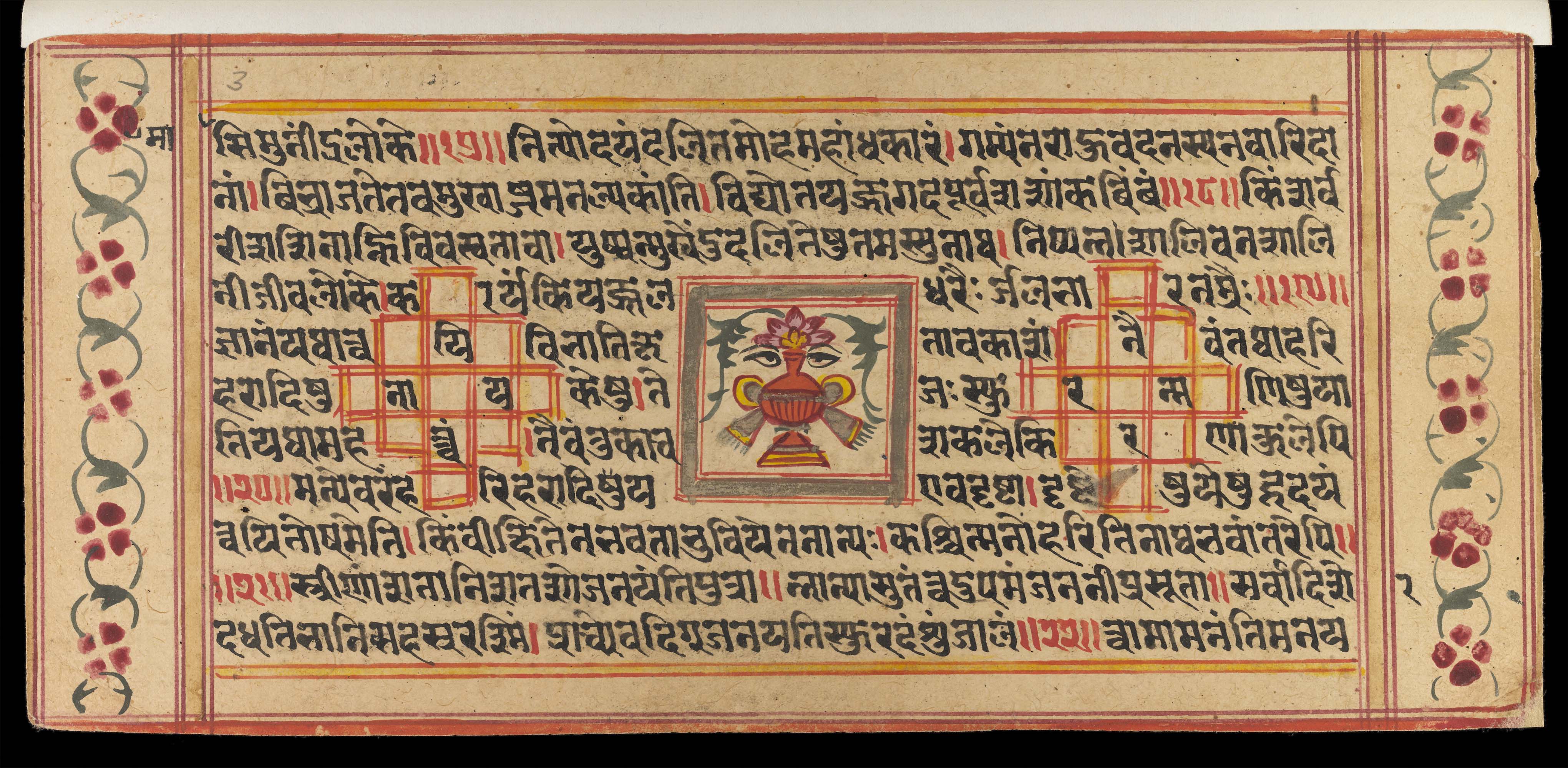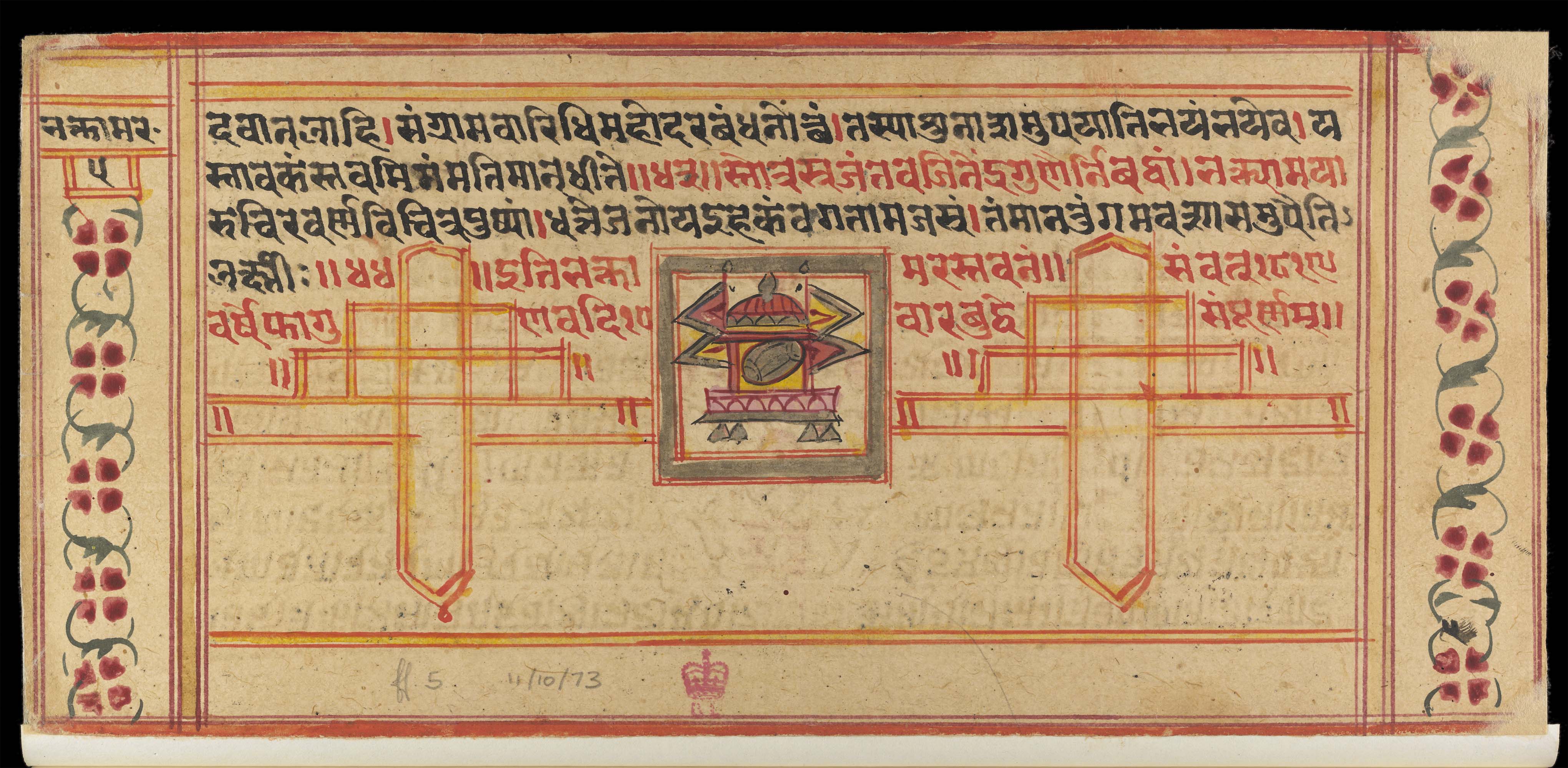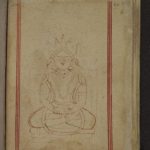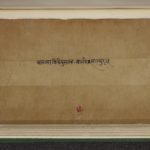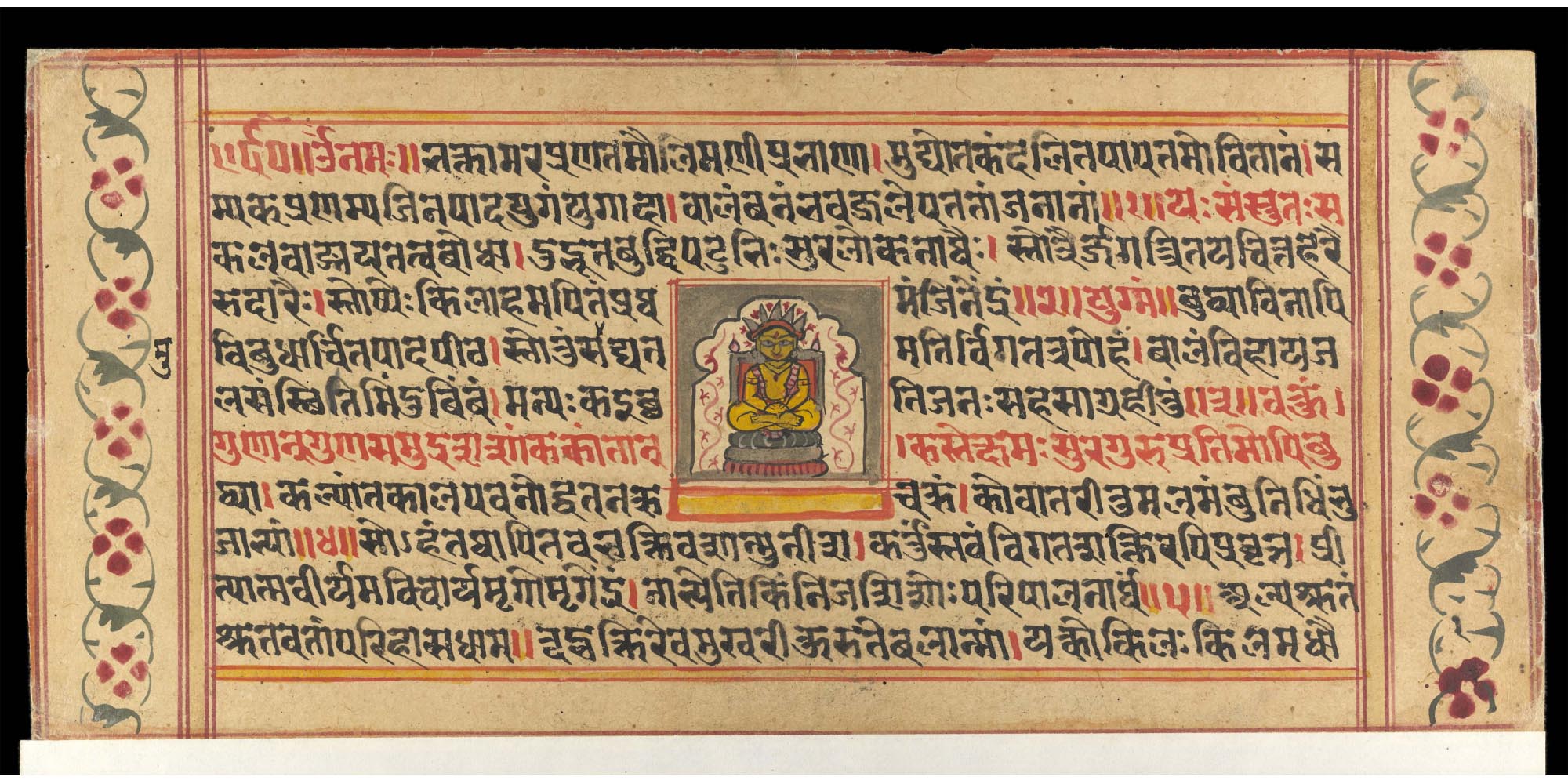
Background
One of the most popular devotional hymns of the Jain hymns is the Bhaktāmara-stotra – Devoted Gods Hymn. With either 44 or 48 stanzas, it is accepted by both main sects of Śvetāmbaras and Digambaras. It is dedicated to the first Jina, Ṛṣabhanātha or Lord Ṛṣabha, frequently known as Ādinātha, meaning ‘First Lord’. The title comes from the first verse, which says that ‘his feet enhance the lustre of the jewels set in the crowns lowered by the devoted gods’.
The Bhaktāmara-stotra is written in Sanskrit in an elaborate poetical style. Many followers know the original text by heart and may daily recite or meditate upon it. This hymn of praise belongs to the categories of Sapta Smarans – ‘Seven Remembrances’ – or Nava Smarans – ‘Nine Remembrances’. These refer to seven or nine popular hymns that form the core of Śvetāmbara Jain liturgy.
Mānatuṅga is the author of this hymn, and a figure who is the starting point of several legends. Recent scholarship considers that he was ‘a Śvetāmbara devotional poet who lived in the second half of the 6th century A.D’ (Wiley 2004: 53).
The Bhaktāmara-stotra has generated a number of commentaries from the 14th century onwards. It is also part of the Jain tantric tradition and is often given a magical value. Manuscripts of this text are often artefacts with noteworthy features. This manuscript demonstrates vignettes in the middle of each side of every folio, showing Jinas, auspicious symbols or mystical diagrams.
Transcription
1. //§O// oṃ namaḥ // bhaktâmara-praṇata-mauli-maṇī-prabhāṇā / m udyotakaṃ dalita-pāpa-tamo-vitānaṃ / sa-
2. myak praṇamya Jina-pāda-yugaṃ yugādā /v ālaṃbanaṃ bhava-jale patatāṃ janānāṃ //1// yaḥ saṃstutaḥ sa-
3. kala-vāṅmaya-tatva-bodhā/ d udbhūta-buddhi-paṭubhiḥ sura-loka-nāthaiḥ / stotrair jagat-tritaya-cittaharai-
4. r udāraiḥ / stoṣye<ḥ> kilâham api taṃ prathamaṃ Jineṃdraṃ //2// yugmaṃ // buddhyā vināpi
5. vibudhârcita-pādapīṭha / stotuṃ samu*dyata-matir vigata-trapo ‘haṃ / bālaṃ vihāya ja-
6. la-saṃsthitam iṃdu-bimbaṃ / m anyaḥ ka icchati janaḥ sahasā grahītuṃ //3// vaktuṃ /
7. guṇān guṇa-samudra śaśāṃka-kāntān / kas te kṣamaḥ sura-guru-pratimo ‘pi bu-
8. ddhyā / kalpāṃta-kāla-pavanôddhata-nakra-cakraṃ / ko vā tarītum alam aṃbu-nidhiṃ bhu-
9. jābhyāṃ //4// so ‘haṃ tathāpi tava bhakti-vaśān munīśa / kartuṃ stavaṃ vigata-śaktir api pravr̥tta / prī-
10. tyâtma-vīryam avicārya mr̥go mr̥geṃdraṃ / nâbhyeti kiṃ nija-śiśoḥ paripālanârthaṃ //5// alpa-śrutaṃ
11. śrutavatāṃ parihāsa-dhāma // tvad-bhaktir eva mukharī-kurute balān māṃ / yat kokilaḥ kila madhau
The asterisk symbol * indicates obvious scribal errors in this manuscript.
In line 5 the syllable mu had been omitted originally, and has been added in the margin, probably by a later user of the manuscript.
Translation
1. //§O// Oṃ homage// They enhance the lustre of the jewels set in the crowns lowered by the devoted gods they shine, they have destroyed the mass of darkness of evil.
2. I have [literally ‘having’] duly bowed to the feet of the Jina, a support for people falling in the ocean of rebirths in the beginning of the era //1// He has been praised [literally ‘he who has been praised’]
3. by the lords of the gods, who have become proficient on account of the insight they acquired by the understanding of the true principles of all sciences in hymns which captivate the three worlds,
4. which are excellent. I too wish to praise this first Jina //2// Although devoid of intelligence,
5. I made my mind to praise you, whose foot-stool is adored by the gods, shameless as I am. Except for a child,
6. who else would wish suddenly to catch the disc of the moon reflected in water? //3//
7. Ocean of qualities, who, even if he compares to Bṛhaspati [the tutor of gods] in intelligence, is able to tell your qualities, [which are] as beautiful as the moon?
8. When the ocean is full of crocodiles stirred by the wind typical of the period marking the end of a kalpa, who is capable of crossing it
9. by swimming? //4// Even then, I, here, out of devotion for you, Lord of ascetics, I have started to write this praise, even though I have no power.
10. Out of affection, without thinking about its strength, the antelope rushes towards the king of animals, doesn’t it, in order to protect its child. //5// I am not learned,
11. I am an object of laugh[ter] for the learned. It is only my devotion for you that forces me to talk. If the cuckoo is said to [sing sweetly] in spring, [it has only one cause: the beautiful bunches of mango-seedlings].
There are several points about the hymn that are worthy of note.
The title of the hymn comes from its very first words, which are bhaktāmara – ‘the devoted gods’.
The identity of the Jina praised in this hymn is not given straightforwardly. Instead, it is mentioned indirectly in the phrase ‘in the beginning of the era’ – yugādau. This refers to the first Jina, Ṛṣabhanātha or Lord Ṛṣabha, who is often called Ādinātha. Meaning ‘First Lord’ or ‘Lord of the Beginning’, Ādinātha’ uses the word ādi – beginning. Using this title emphasises the inaugural position of this Jina. Yugādīśa – ‘Lord of the beginning of the era’ – is another of his titles that also underlines this point.
The author’s habit of expressing humility and incapacity for the task he has set for himself is expressed here in particularly extreme terms. This is a way to stress the power of devotion – bhakti – and hence the greatness of the Jina. If the author has any right and capacity to compose a hymn of praise – stotra – it is only because he is devoted to the Jina. Thus he as an individual has no importance.
Glossary
Description
Manuscripts of the Bhaktāmara-stotra are often artefacts with noteworthy aesthetic features, which underline the particular value and presence of this hymn in the Jain tradition. The song has magic powers and is part of the Jain tantric tradition, associated with mantras and yantras.
Each recto and verso page of this manuscript has a central vignette. All different from each other, they depict auspicious symbols or figures.
Here the painting shows a Jina seated cross-legged, in padmāsana. This is one of the two meditation poses in which a Jina can be shown. The Jina is represented in the typical Śvetāmbara style, as he is depicted with a garland, a crown and an ornamental tilaka on the forehead. Here the crown has five spikes.
The Jina is seated on a raised throne with a back. This is a painting of a Jina image in the cella of a temple, as the background shows.
There is no identifying emblem as such, but this is most likely to be the first Jina, Ṛṣabhanātha or Lord Ṛṣabha also called Ādinātha as the Bhaktāmara-stotra is dedicated to him.
On the other hand, this hymn can be viewed as a praise for the nature and power of a Jina in general, since it does not include individual characteristics. So it is appropriate that the opening image does not focus on an individual Jina.
Selected pages of this manuscript are digitised on JAINpedia.
Other visual elements
There are several notable things about this page.
- The bottom right-hand lower corner has ‘1’ between the ornamental motifs, which is the folio number.
- Verse numbers are at the end of each stanza and are often written in red between two vertical lines, like here.
- The margins are decorated with an ornamental motif of flowers and leaves.
Script
The elaborate script is the Jaina Devanāgarī script, here written in a form which recalls calligraphy. It is used for writing numerous Indian languages, here for Sanskrit.
The red vertical lines – daṇḍas – within the text are used to divide the parts of a verse. Single ones mark the end of a pāda, a verse part. Double ones mark the end of the whole verse.
On this page red ink is also used for some words. Red is used to write:
- the beginning of verse 2 and a large part of verse 4. These are haphazard choices from the scribe, without any apparent motivation.
- the word yugmaṃ, towards the end of line 4, which means ‘pair’ and is used at the end of two verses that have to be read together to make sense.
- Source:
The British Library Board
- Shelfmark:
Or. 13478
- Author:
Mānatunga
- Date of creation:
1762
- Folio number:
1 verso
- Total number of folios:
5
- Place of creation:
western India
- Language:
Sanskrit
- Medium:
paper
- Size:
25.5 x 11.5 cms
- Copyright:
CC0 1.0 (Creative Commons Public Domain)
- Image Copyright:
- +
- aAbhavya
- aAbhinandana
- aAbhiṣeka
- aĀcāra
- aĀcārāṅga-sūtra
- aĀcārya
- aAchalbhrata
- aAḍhāī-dvīpa
- aAdharma
- aAdho-loka
- aAdhyayana
- aAdvaita Vedānta
- aĀgama
- aAghātīya
- aAghātīya-karman
- aAgnibhuti
- aAgra
- aĀhāra
- aAhiṃsā
- aAhimsa Day
- aAjita
- aAjīva
- aAkampit
- aĀkāśa
- aAkbar the Great
- aAkṣaya-tṛtīyā
- aAlauddin Khalji
- aAlbert Einstein
- aAllah
- aAlms
- aĀlocanā
- aAloka-ākāśa
- aAmāri
- aAmbikā or Kūṣmāṇḍinī
- aAnagāra
- aAnanta
- aAnarthadaṇḍa
- aAnaśana
- aAnekānta-vāda
- aAṅga
- aAniconism
- aAnojjā
- aAntarāla
- aAntarāya-karma
- aAṇu
- aAṇu-vrata
- aAnukampā
- aAnuprekṣā
- aAnusvāra
- aApabhraṃśa
- aAparigraha
- aAra
- aĀrambha
- aĀrambhaja
- aĀratī
- aArdhamāgadhī Prākrit
- aArhaṃ
- aArhat
- aArśana-āvaraṇīya-karma
- aĀrta-dhyāna
- aĀryikā
- aĀryikā Jñānamati
- aĀśātanā
- aĀścarya
- aAscetic
- aAsceticism
- aAshram
- aAspiration
- aĀsrava
- aAṣṭa-maṅgala
- aAṣṭāpada
- aAstikāya
- aAstrolabe
- aAsura
- aAtheism
- aAticāra
- aAtiśayakṣetra
- aAtithisaṃvibhāgavrata
- aĀtma-vāda
- aĀtman
- aAuṃ
- aAurangzeb
- aAuspicious
- aAusterity
- aAvadhāna
- aAvadhi-jñāna
- aĀvaraṇī-yakarman
- aAvasarpiṇī
- aAvatāra
- aAvidyā
- aAxiom
- aĀyāga-paṭa
- aĀyambil
- aĀyu-karma
- aĀyurveda
- bBabur
- bBāhubali
- bBaladeva
- bBālāvabodha
- bBandha
- bBasadi
- bBazaar
- bBhadrankarvijay
- bBhagavant
- bBhaktāmara-stotra
- bBhakti
- bBhale
- bBharata
- bBhāṣā
- bBhāṣya
- bBhaṭṭāraka
- bBhāva
- bBhāva-pūjā
- bBhāvanā
- bBhavana-vāsin
- bBhavya
- bBhavyatva
- bBhaya
- bBhoga-bhūmi
- bBhogopabhoga
- bBodhi
- bBollywood
- bBrahmā
- bBrahma-deva
- bBrahmacārī
- bBrāhmaṇa
- bBraj Bhāṣā
- bBright fortnight
- bBritish Raj
- bBuddha
- bBuddhi-sagar
- bBuddhism
- bBuddhist
- cCaitya
- cCaityavāsin
- cCakravartin
- cCakreśvarī
- cCāmara
- cCandanā
- cCandragupta
- cCandraprabha
- cCanon
- cCāritra
- cCāritramohanīya-karman
- cCarũrī
- cCaste
- cCaturvidha-saṅgha
- cCaturviṃśati-stava
- cCāturyāma
- cCE
- cCelibacy
- cCha
- cChadmastha
- cChastity
- cCheda-sūtra
- cChristian
- cChristianity
- cClergy
- cCloning
- cColophon
- cCommentary
- cConch
- cConfession
- cCongregation
- cConsecration
- cCosmology
- cCremation
- cCrore
- cCult
- cCūrṇi
- dDādā-guru
- dDalit
- dDāna
- dDaṇḍa
- dDark fortnight
- dDarśana
- dDarśanamohanī-yakarman
- dDaśa-lakṣaṇa-parvan
- dDeity
- dDelhi Sultanate
- dDerāsar
- dDeśāvakāśika-vrata
- dDetachment
- dDevanāgarī
- dDevānandā
- dDevarddhi-gani
- dDevotee
- dDhamal
- dDhanuṣ
- dDhāra
- dDharma
- dDharma-dhyāna
- dDharma-sāgara
- dDharmastikaya
- dDhātakīkhaṇḍa
- dDholak
- dDhyāna
- dDiaspora
- dDig-vrata
- dDigambara
- dDīkṣā
- dDisciple
- dDīvālī
- dDivya-dhvani
- dDNA
- dDoctrine
- dDogma
- dDonor
- dDoṣa
- dDravya
- dDravya-pūjā
- dDrone
- dDuṣamā
- dDuṣamā-duṣamā
- dDuṣamā-suṣamā
- dDveṣa
- dDvīpa
- eEast India Company
- eEightfold Path
- eEkānta-vāda
- eEkendriya
- eElder
- eElders
- eEschatology
- eEtc up to
- fFarmān
- fFast
- fFatehpur Sikri
- fFestival
- fFestschrift
- fFiruz Shah
- fFly-Whisks
- fFolio
- fFour Noble Truths
- gGaccha
- gGaṇa
- gGaṇadhara
- gGanadharavada
- gGaṇeśa
- gGaṇin
- gGarba
- gGarbha
- gGarbha-gṛha
- gGaruḍa
- gGati
- gGene
- gGenomics
- gGhātī-yakarman
- gGhātīya
- gGhaznavid
- gGhiyasuddin Tughlaq
- gGhurid
- gGloss
- gGotra-karma
- gGujarāt
- gGujarati
- gGuṇa
- gGuṇa-sthāna
- gGuṇa-vrata
- gGupti
- gGuru
- gGuruṇī
- hHagiography
- hHajj
- hHaṃsa
- hHaribhadra
- hHariṇaigameṣin
- hHasta
- hHeresy
- hHiṃsā
- hHindi
- hHindu
- hHinduism
- hHīravijaya
- hHoroscope
- hHrīṃ
- hHumayun
- hHymn
- iIconoclasm
- iIconography
- iIdol
- iIndian Independence
- iIndology
- iIndra
- iIndrabhūti Gautama
- iIndriya
- iInitiation
- iIntercession
- iInvocation
- iIQ
- iIslam
- iIslamicate
- iIṣṭadevatā
- iĪśvara
- jJagat
- jJahangir
- jJain
- jJaina Devanāgarī
- jJaina Śaurasenī
- jJaina-dharma
- jJainaśāsana
- jJainness
- jJaisalmer
- jJamāli
- jJambū-dvīpa
- jJames Burgess
- jJanma
- jJanma-kalyāṇa
- jJarā
- jJāti
- jJina
- jJina-āgama
- jJina-bhavana
- jJina-bimba
- jJina-mātā
- jJinacandra-sūri
- jJinadatta
- jJinaprabha
- jJīva
- jJñāna
- jJñāna-āvaraṇīya-karma
- jJñāna-āvarṇiya
- jJñānsundar
- jJyotiṣka
- kKāla
- kKālakācārya-kathā
- kKālidāsa
- kKalpa-sūtra
- kKalpa-vṛkṣa
- kKalyāṇaka
- kKalyanvijay
- kKamaṇḍalu
- kKamaṭha
- kKarma
- kKarma-bhūmi
- kKarma-grantha
- kKarma-prakṛti
- kKarma-vāda
- kKarmon
- kKarnataka
- kKaṣāya
- kKathā
- kKāvya
- kKāya
- kKāyotsarga
- kKeśa-loca
- kKetu
- kKevala-jñāna
- kKevalin
- kKhalji
- kKharatara-gaccha
- kKnowledge
- kKriyā
- kKriyā-vāda
- kKṛṣṇa
- kKṣamā-śramaṇa
- kKṣapakaśreṇi
- kKṣatriya
- kKṣullaka
- kKulakara
- kKundakunda
- kKunthu
- lLabdhi
- lLaity
- lLakh
- lLāñchana
- lLands of Action
- lLaukāntika
- lLavaṇa-samudra
- lLeśyā
- lLiṅga
- lLinguistics
- lLoka
- lLoka-ākāśa
- lLoka-puruṣa
- lLoka-vāda
- lLotus
- lLotus lake
- mMadhya-loka
- mMahā-videha
- mMahā-vrata
- mMahābhārata
- mMahāmastakābhiṣeka
- mMāhārāṣṭra
- mMāhārāṣṭrī Prākrit
- mMahattarā Yākinī
- mMahāvīr Jayantī
- mMahāvīra
- mMakāra
- mMakkhali Gośāla
- mMalli
- mMāna-stambha
- mManaḥ-paryāya-jñāna
- mMaṇḍala
- mMaṇḍapa
- mMandit
- mMaṅgala
- mMantra
- mMantras
- mManuṣya-loka
- mMarāṭhī
- mMārgaṇā
- mMartyr
- mMarudevī
- mMaṭha
- mMati-jñāna
- mMauryaputra
- mMecca
- mMendicant lineage
- mMetarya
- mMiracle
- mMithyādṛṣṭi
- mMohandas Gandhi
- mMohanīya-karma
- mMokṣa
- mMonastic order
- mMonasticism
- mMonk
- mMonotheism
- mMosque
- mMount Meru
- mMount Sammeta
- mMṛgāvatī
- mMughal
- mMuhammad
- mMuhammad bin Tughlaq
- mMuhpattī
- mMūla-sūtra
- mMūlaguṇa
- mMumbaī
- mMuni
- mMunisuvrata
- mMurad Bakhsh
- mMūrti-pūjaka
- mMuslim
- mMysticism
- nNābhi
- nNāga-kal
- nNāgapurīya Tapā-gaccha
- nNāgarī
- nNāma-karma
- nNamaskāra-mantra
- nNami
- nNandīśvara-dvīpa
- nNandivardhana
- nNandyāvarta
- nNāraka
- nNāraki
- nNasalisation
- nNātha
- nNavrātrī
- nNaya-vāda
- nNemi
- nNidāna
- nniggaṃthāṇa vā 2
- nniggaṃtho vā 2
- nNigoda
- nNihnava
- nNikṣepa
- nNirgrantha
- nNirjarā
- nNirvāṇa
- nNiryukti
- nNiṣidhi
- nNitya
- nNiyati
- nNo-kaṣāya
- nNudity
- nNun
- oOcean of milk
- oOmniscience
- oOrdination
- ppa°
- pPadmaprabha
- pPadmāsana
- pPadmāvatī
- pPādukā
- pPalanquin
- pPalette
- pPañca-muṣṭi
- pPāṇḍava
- pPaṇḍit
- pPandit Dalsukh D. Malvania
- pPandit Sukhlalji
- pPāṇipātra
- pPāpa
- pParamātman
- pParameṣṭhin
- pPāraṇā
- pParigraha
- pPariṇāma
- pParīṣaha
- pParokṣa
- pPārśva
- pPārśvanātha
- pParyāya
- pParyuṣaṇ
- pPaṭa
- pPatan
- pPātra
- pPenance
- pPersian
- pPhala
- pPhilology
- pPicchikā
- pPilgrimage
- pPīr
- pPolymath
- pPoṣadha
- pPossession
- pPothī
- pPrabhas
- pPradakṣiṇā
- pPradeśa
- pPrākāra
- pPrakīrṇaka-sūtra
- pPrākrit
- pPramāda
- pPramukhā
- pPrati-vāsudeva
- pPratikramaṇa
- pPratimā
- pPratiṣṭhā
- pPratyākhyāna
- pPratyakṣa
- pPravacana
- pPrāyaścitta
- pPrayer
- pPre-modern
- pPreach
- pPredestination
- pProtestant
- pProvenance
- pPudgala
- pPūjā
- pPujārī
- pPukharavara-dvīpa
- pPuṇya
- pPūrva
- pPuṣkara-dvīpa
- pPuṣpadanta
- pPyre
- qQur’an
- rRāga
- rRāhu
- rRainy season
- rRajasthan
- rRajasthani
- rRājimatī
- rRajoharaṇa
- rRajput
- rRāma
- rRāmāyaṇa
- rRangoli
- rRās-garbā
- rRasa
- rRathanemi
- rRatna-traya
- rRātri-bhojana
- rRaudra-dhyāna
- rRecto
- rRelic
- rRenunciation
- rRetroflex
- rRevatī
- %Ṛg-veda
- rRite
- rRosary
- %Ṛṣabha
- %Ṛṣabhanātha
- rRupee
- sSaciyā Mātā
- sSādhu
- sSādhvī
- sSāgāra
- sSaint
- sŚaivaism
- sŚaka-saṃvat
- sSallekhanā
- sŚalya
- sSamacatuṣṭha
- sSamādhimaraṇa
- sSamaṇi
- sSāmarambha
- sSamavasaraṇa
- sSāmāyika
- sSaṃbhava
- sSamiti
- sSaṃjñā
- sSaṃkalpaja
- sSaṃsāra
- sSamudghāta
- sSaṃvara
- sSaṃvega
- sSamyak-cāritra
- sSamyak-darśana
- sSamyak-jñāna
- sSamyaktva
- sSaṃyama
- sSanctuary
- sSandalwood
- sSaṇgha
- sSanskrit
- sSant
- sŚānti
- sSapta-bhaṅgi-naya
- sSārambha
- sSarasvatī
- sSarvajña
- sSāsan-devi
- sŚāsana-devatā
- sŚāstra
- %Ṣaṭ-jīvanikāya
- sSatī
- sSatīmātā
- sSatya
- sSchism
- sScribe
- sScripture
- sSect
- sSecularism
- sŚenāī
- sSermon
- sŚeṣavatī
- sSevā
- sSeven fields of donation
- sShah Jahan
- sShantidas Jhaveri
- sShrine
- sSiddha
- sSiddha-śilā
- sSiddhacakra or Navadevatā
- sSiddhānta
- sSiddhārtha
- sSiddhi
- sSikh
- sSikhism
- sŚikṣā-vrata
- sŚīla
- sSin
- sSindh
- sŚītala
- sŚiva
- sSkandha
- sSomanatha
- sŚraddhā
- sŚramaṇa
- sŚrāvaka
- sŚrāvakācāra
- sŚrāvikā
- sŚreyāṃsa
- sŚrī
- sŚrīvatsa
- sŚruta-jñāna
- sŚruta-pañcamī
- sSthānaka-vāsin
- sSthāpanācārya
- sSthāvara
- sSthavira
- sSthiti
- sStrīmukti
- sStūpa
- sSubcontinent
- sSudarshana
- sŚuddhi
- sSudharma
- sŚūdra
- sSufism
- sSukha
- sŚukla-dhyāna
- sSulasā
- sSultan
- sSumati
- sSundarśrī
- sSupārśva
- sSūri
- sSuṣamā
- sSuṣamā-duṣamā
- sSuṣamā-suṣamā
- sSūtra
- sSuyam me ausam! Tenam bhagavaya evamakkhayam
- sSvādhyāya
- sSvāhā
- sSvastika
- sŚvetāmbara
- sŚvetāmbara Terāpanthin
- sŚvetāmbaras
- sSwan
- sSyād-vāda
- tTabla
- tTantra
- tTapā-gaccha
- tTapas
- tTāraṇ Svāmī Panth
- tTattva
- tTattvārtha-sūtra
- tTemple
- tTemple-city
- tThe Enlightenment
- tTheology
- tThree worlds
- %Ṭīkā
- tTilaka
- tTīrtha
- tTīrthaṃkaranāma-karman
- tTīrthankara
- tTransliteration
- tTrasa
- tTrasa-nāḍī
- tTriśalā
- tTriṣaṣṭi-śalākā-puruṣa-caritra
- tTti bemi
- tTughlaq
- tTunk
- uUdumbara
- uUniversal History
- uUpādhyāya
- uUpāṅga
- uUpaniṣads
- uUpāsaka
- uUpasarga
- uUpāśraya
- uŪrdhva-loka
- uUtsarpiṇī
- uUttarādhyayana-sūtra
- vVāhana
- vVaimānika
- vVairāgya
- vVaiṣṇava
- vVaiśramaṇa
- vVaiśya
- vValabhī
- vVanaspatikāya
- vVandana
- vVaṇik
- vVarṇa
- vVāsudeva
- vVāsupūjya
- vVayubhūti
- vVeda
- vVedanīya-karma
- vVegetarianism
- vVehicle
- vVernacular
- vVerso
- vVidyā
- vVidyā-devī
- vVihāra
- vVijñapti-patra
- vVikrama-saṃvat
- vVikṛti
- vVimala
- vVinaya
- vVipāka
- vVirji Vora
- vVirodhaja
- vVīrya
- vVisarga
- vViṣṇu
- vVītarāga
- vVizier
- vVotive
- vVow
- vVrata
- vVS
- vVyakta
- vVyantara
- vVyasana
- yYakṣa
- yYakṣī
- yYantra
- yYaśoda
- yYaśovijaya
- yYati
- yYātrā
- yYoga
- yYoginī
- yYojana
Description
Manuscripts of the Bhaktāmara-stotra are often artefacts with noteworthy aesthetic features, which underline the particular value and presence of this hymn in the Jain tradition. The song has magic powers and is part of the Jain tantric tradition, associated with mantras and yantras.
Each recto and verso page of this manuscript has a central vignette. All different from each other, they depict auspicious symbols or figures.
Here the painting shows a Jina seated cross-legged, in padmāsana. This is one of the two meditation poses in which a Jina can be shown. The Jina is represented in the typical Śvetāmbara style, as he is depicted with a garland, a crown and an ornamental tilaka on the forehead. Here the crown has five spikes.
The Jina is seated on a raised throne with a back. This is a painting of a Jina image in the cella of a temple, as the background shows.
There is no identifying emblem as such, but this is most likely to be the first Jina, Ṛṣabhanātha or Lord Ṛṣabha also called Ādinātha as the Bhaktāmara-stotra is dedicated to him.
On the other hand, this hymn can be viewed as a praise for the nature and power of a Jina in general, since it does not include individual characteristics. So it is appropriate that the opening image does not focus on an individual Jina.
Selected pages of this manuscript are digitised on JAINpedia.
Other visual elements
There are several notable things about this page.
- The bottom right-hand lower corner has ‘1’ between the ornamental motifs, which is the folio number.
- Verse numbers are at the end of each stanza and are often written in red between two vertical lines, like here.
- The margins are decorated with an ornamental motif of flowers and leaves.
Script
The elaborate script is the Jaina Devanāgarī script, here written in a form which recalls calligraphy. It is used for writing numerous Indian languages, here for Sanskrit.
The red vertical lines – daṇḍas – within the text are used to divide the parts of a verse. Single ones mark the end of a pāda, a verse part. Double ones mark the end of the whole verse.
On this page red ink is also used for some words. Red is used to write:
- the beginning of verse 2 and a large part of verse 4. These are haphazard choices from the scribe, without any apparent motivation.
- the word yugmaṃ, towards the end of line 4, which means ‘pair’ and is used at the end of two verses that have to be read together to make sense.





























































































